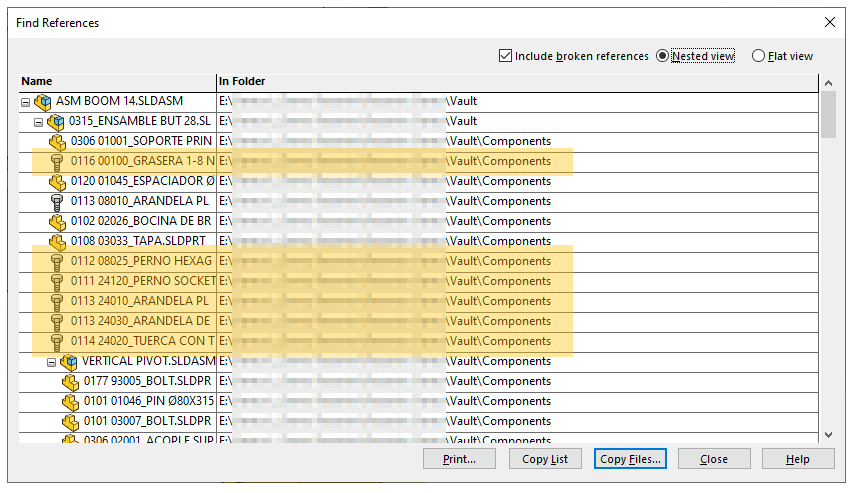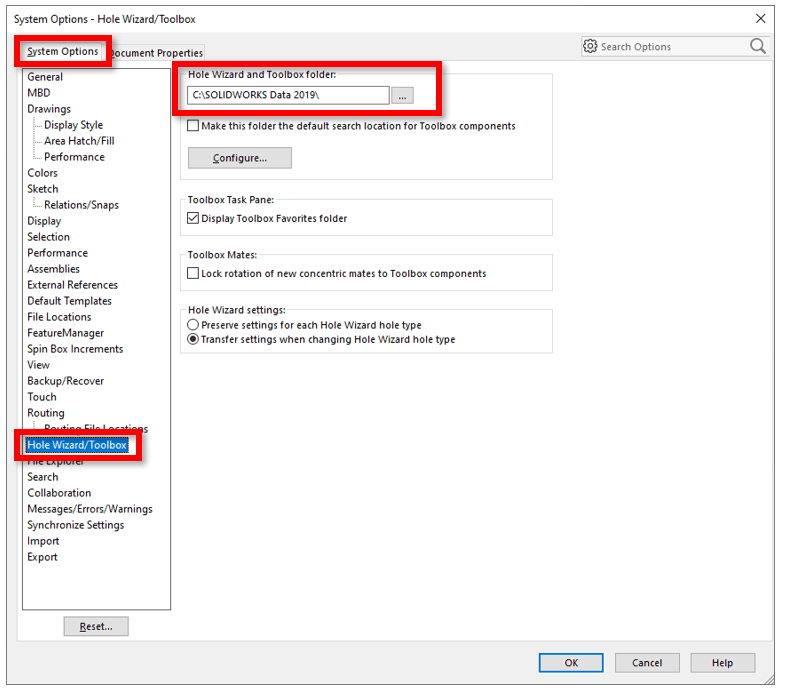Toolbox Default Search Location
What Happened to my Toolbox parts?!

When SOLIDWORKS introduced a feature to help users open models with missing Toolbox references in 2011, there was much confusion on what the option does. Even today, this question still comes up, so this is the topic for today’s blog.

According to the help file here’s what this option does:
Facilitates opening models whose Toolbox components do not reference your Toolbox folder. If you clear the system option, SOLIDWORKS does not automatically search the Toolbox folder for references to Toolbox components.
Clear as mud, right? That last bit about not searching the Toolbox folder is a bit misleading because it does still search this folder; I’ll explain that part later in the last section of this article. The intent of the option when turned on, is to have toolbox search a specific location for the correct part and configuration if toolbox parts are detected REGARDLESS of the saved references. So, a better way to understand this option is, it forces ALL Toolbox files to open from this path. In this specific case (first image above) the correct fastener was not in my library, so a DEFAULT size was created and used by SOLIDWORKS. While the fastener info should be saved in the assembly, SOLIDWORKS did not correctly determine the right configuration to use which is why we see the incorrect fastener length used in this example. Not all Toolbox databases are created equal!
So why does the image on the right show the correct fastener? What’s going on here?

The short answer is, check your file references (File -> Find References). When this assembly was saved to a folder, using pack-and-go, a copy of the Toolbox parts were also saved. This means that the assembly file now contains references to specific Toolbox parts to use. The original user knew that the person receiving this assembly would not have the exact same database of fasteners, so they also sent a copy of their Toolbox parts with custom names, properties, part numbers, etc.; Smart thinking!
For the user receiving the assembly, if the above-mentioned option is turned on, SOLIDWORKS only sees that the component is a Toolbox part; and even though the correct reference has been saved in the assembly references, it OVERRIDES the reference and opens a fastener that didn’t yet exist in the database, in this case, picking the wrong size. If the user doesn’t see this mistake, makes some changes to the assembly then saves, this will OVERWRITE the original references and use parts out of a local database of fasteners. To make matters worse, the only way to correct the mistake is to physically select the correct size from the toolbox and create the correct configuration for each size. So, if something like this happens to you, don’t save. Try turning off the option and re-open the assembly to see if SOLIDWORKS selects the correct part that might have been sent with the assembly. In my opinion, this option should be OFF by default.
Okay, but these are my models, not something that was sent to me; why are my toolbox parts the incorrect size?
This could be due to SOLIDWORKS using the wrong toolbox database. Double check the path in your settings to the toolbox data folder. Did someone perform an upgrade recently? Should the path be pointing to a shared toolbox database on the network or maybe in a PDM Vault? Once you update your settings with the correct path and database, your models should open without issue. Double check with your I.T. Department or a colleague to make sure you are using the correct parts. DO NOT SAVE your assembly with incorrect references; if you do, you will have to re-select the correct hardware.

How can I prevent this issue from happening in the future?
The short answer is this; Turn the option OFF (make this folder the default search location for toolbox components), SOLIDWORKS will open the file referenced by the assembly. If SOLIDWORKS can’t find the part in the original reference folder, and you have Toolbox, SOLIDWORKS will then reference the current toolbox data folder and ask you if Toolbox should create a new part. This is due to a special property saved in all toolbox parts. With the option on, it simply ignores the saved reference in the assembly and goes to the data folder as a default even if the correct file existed; like it was never there.
Alternatively, you could remove the Toolbox part flag. This will prevent SOLIDWORKS from recognizing the component as a Toolbox part, and the assembly will not look in the Toolbox data folder regardless of how you set the above option. For instructions on how to remove the Toolbox flag property, read this article on our blog from 2011. Typically, you should only remove the flag if you have made custom modifications to the part, and don’t need it managed by Toolbox anymore. Removing the property would also let you check the part into PDM as a normal revision tracked part; an added benefit!
Alex Worsfold
Application Engineer, CSWE
Computer Aided Technology, LLC

 Blog
Blog